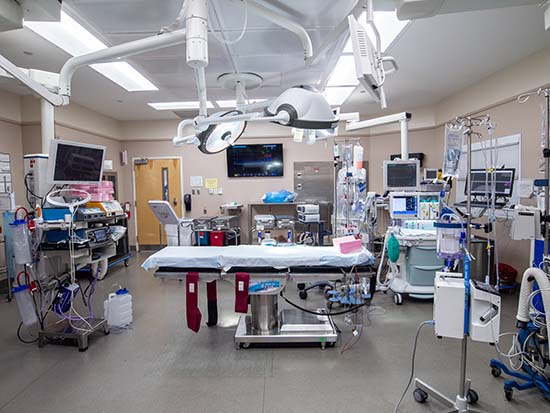By Allie Hulcher
UAB News
2021 was a record year for the University of Alabama at Birmingham Trauma Center, with a record number of patients evaluated and admitted accompanied by the highest quality of care metrics the center has ever had.
UAB is home to the state’s only American College of Surgeons-verified adult Level I Trauma Center, meaning it has met a rigorous standard and sees patients with the most severe traumatic injuries, like those from car crashes, gun violence and falls from across Alabama and neighboring states.
In 2021, UAB saw a historic increase in volume, handling 6,466 trauma evaluations — a 17 percent increase over the last year and a 34 percent increase over the past two years. There were 4,568 trauma admissions — a 10 percent increase from 2020. They also saw a 27 percent increase over the past two years in the amount of severely injured patients admitted to the hospital.
Daniel Cox, M.D., chief of the UAB Trauma Service and associate professor in the UAB Division of Trauma and Acute Care Surgery, says in the past it has taken about eight years to see an increase of 1,000 trauma evaluations — but the trauma center reached that increase in the span of just a year in 2021.
The UAB Trauma Center’s rise in volume was accompanied by an increase in its level of care. 2021 saw UAB’s highest survival rate ever, at 96 percent. According to metrics from the National Trauma Quality Improvement Program from the ACS, in comparison to hospitals with similar trauma volumes and adjusting for the complexity of cases, UAB was in the top 10 percent for survival rates for patients with penetrating injuries, shock patients, elderly patients with blunt injuries and patients with multisystem blunt injuries.
“Our care metrics were shown to be some of the best in the country, despite the volume and the acuity of the cases we’ve seen,” said Jeffrey Kerby, M.D., Ph.D., director of the UAB Division of Trauma and Acute Care Surgery and the Brigham Family Endowed Professor in Trauma and Acute Care Surgery. “That’s a testament to all the surgeons and the staff who contribute to the trauma program and are passionate about what they do.”
Additional Advanced Practice Providers
One reason the volume of patients has increased is a restructuring of the trauma service to a more efficient model. Beginning in August of 2018, the trauma service began a one-and-a-half-year process with UAB Hospital’s Clinical Practice Transformation to shave time off the average length of stay for trauma patients. They did this in part by hiring 12 additional advanced practice providers for a process that ultimately began implementation in the spring of 2020. The result? The length of stay was decreased by 1.4 days on average — allowing the trauma service to admit 46 more patients a month. In 2021, the trauma center saw a record low in trauma system overload, when the trauma service is at capacity and has to divert patients to other hospitals. The total amount of time in 2021 that UAB was on diversion was 6.5 days — down 96 percent over the previous three years.

“We felt strongly that, as we are the only ACS Level I Adult Trauma Center in the state, the residents of Alabama rely on us to be able to provide the highest quality of trauma care,” Cox said. “We must be open and available for the injured patient in their hour of need.”
UAB’s increasingly high volume of trauma patients also mirrors and exceeds national trends of more injuries due to gun violence and vehicular accidents, but also paints a picture of a state trauma system in crisis.
Alabama has wide areas that are considered “trauma deserts” because of the lack of access to appropriate high-level definitive care for trauma patients. These deserts are caused in part by a lack of critical trauma resources at rural hospitals and have led to an increase in the length of time it takes for people to reach trauma care, as a 2020 study from investigators at UAB’s Center for Injury Science and the UAB Heersink School of Medicine found. The study found that more than 470,000 residents in Alabama were unable to access a hospital within a 30-minute drive.
Kerby serves as Alabama’s first state trauma consultant. And starting in March, Kerby will have a significant influence on trauma systems nationwide when he steps into the role of chair of the ACS Committee on Trauma, a group renowned for tackling global issues of trauma through education, advocacy, injury prevention measures and establishing standards of care.
According to Kerby, Alabama needs to invest in building on the current trauma system infrastructure to ensure patients get the right care at the right time — wherever in the state they are. With enough hospitals participating at a higher level, he says, Alabama is poised to have one of the best trauma systems in the country. Alabama has unique aspects, like being one of only a few states to have a Trauma Communications Center, which monitors the status of trauma hospitals across Alabama so patients are routed to the appropriate facility for their injuries in a timely manner — improving survival rates.
Number Of Initiatives
The Division of Trauma and Acute Care Surgery is not just reacting to a strained statewide system by providing excellent care — they are attempting to heal it through a number of initiatives. For example, the division offers the Rural Trauma Team Development Course to rural hospitals across the state. The course empowers these hospitals to evaluate and resuscitate the seriously injured and to determine whether the patient needs to be transferred to a hospital that can offer a higher level of care.
The division also teaches courses in Stop the Bleed, which trains people to perform lifesaving measures in an emergency like applying a tourniquet and pressure on a serious wound. The division has taught Stop the Bleed courses to teachers and students in schools across central Alabama.
Working with community leaders, the Health Alliance for Violence Intervention and the Jefferson County Department of Health, the division is in the early stages of a Hospital-based Violence Intervention Program in Birmingham, which will pair mentors with survivors in the inpatient setting to connect them with resources with the goal of breaking cycles of violence.
“Besides taking care of our patients, we’re also working outside of the hospital in the realm of injury prevention, community education and advocacy to reduce the number of traumatic injuries and preventable deaths across the state,” Kerby said.
Alabamians need to be able to access the level of care required in a timely manner, no matter where in the state they are injured, Kerby says — but in the meantime?
“The UAB Trauma Center will continue its focus on access and quality of trauma care to be ready to assist in a patient’s moment of crisis,” he said.





